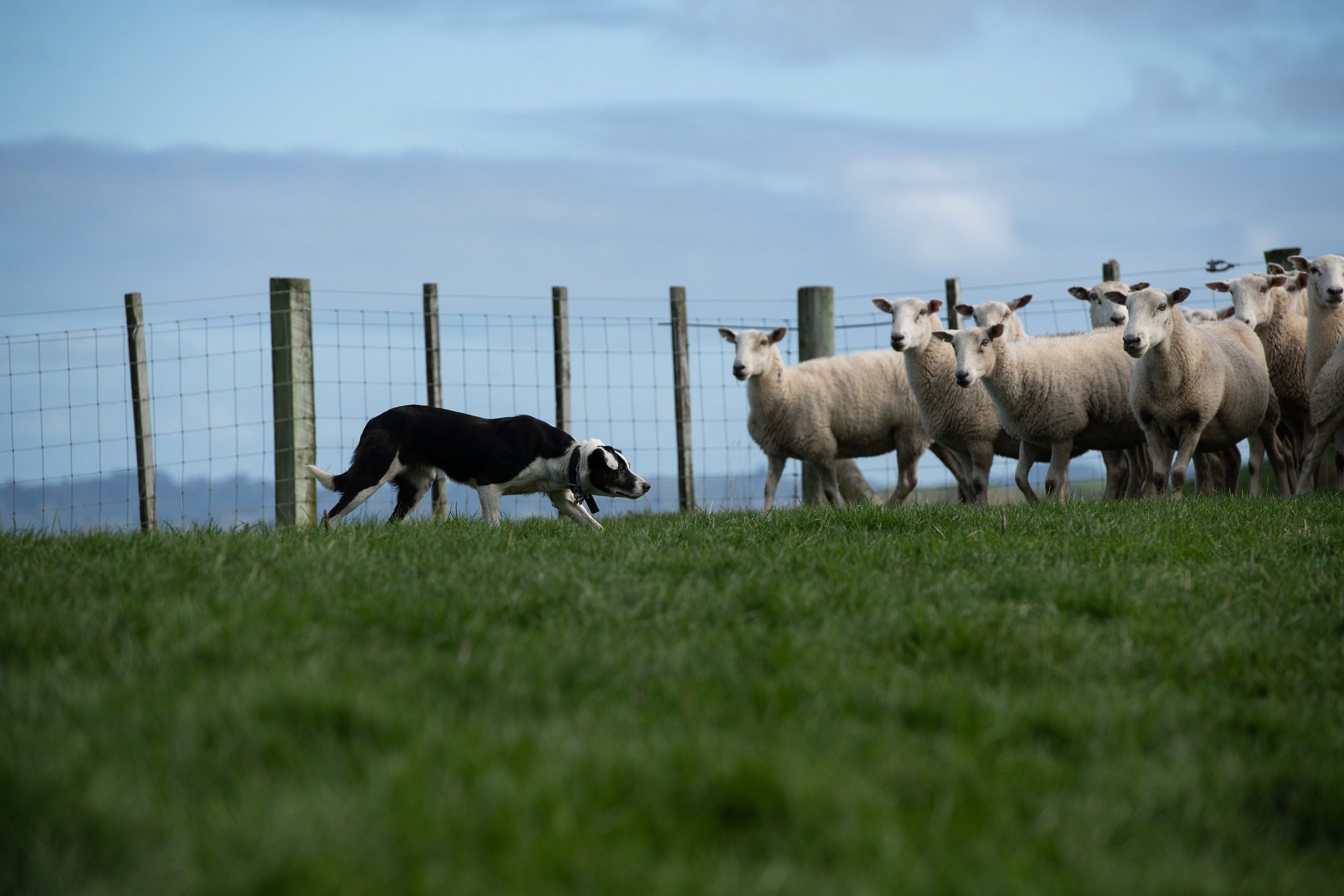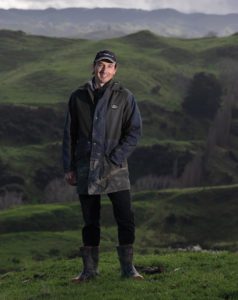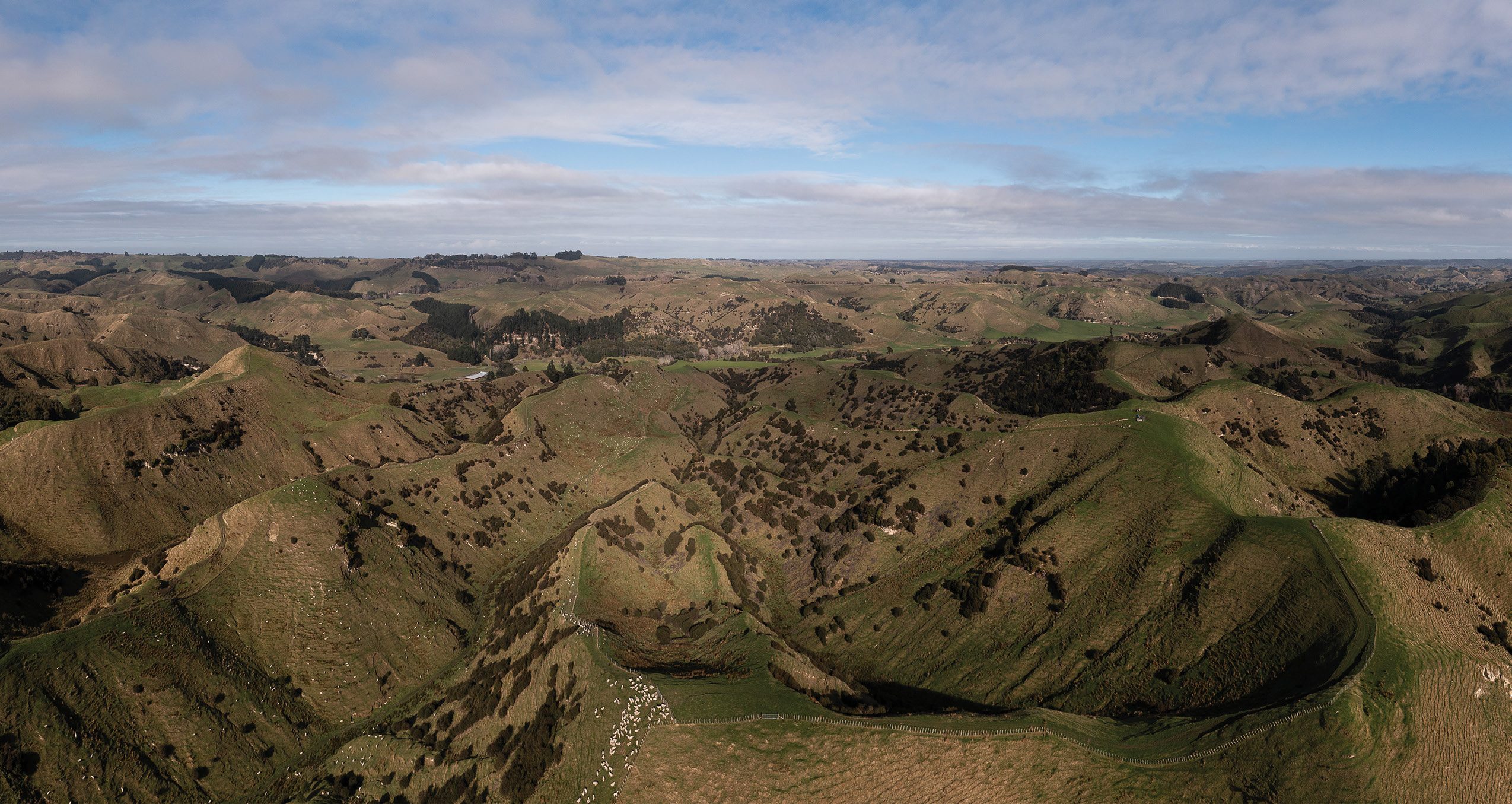Eyeing up the opportunities
Developing the Ezicare breed has meant the Morrisons can focus on meat with a little wool on the side. By Russell Priest. Photos: Brad Hanson.

Developing the Ezicare breed has meant the Morrisons can focus on meat with a little wool on the side. By Russell Priest. Photos: Brad Hanson.
Faced with increasing costs of growing wool, Marton-based Morrison Farming Limited (MFL) have over the past 30 years developed their own composite breed of sheep called Ezicare.
‘We believe we’ve trimmed $12-$15 a head off the costs of growing wool by developing this breed,” manager for MFL Daniel Clayton says.
Based on the Coopworth, Texel and Wiltshire breeds the objectives in establishing the breed were to produce an easy-care, highly fertile and fecund breed capable of generating 18kg high-yielding carcases in 100 days at a 160% weaning rate while still producing a fleece. Minimal dagging, once-a-year shearing, a high degree of FE (facial eczema) and worm tolerance and use of hybrid vigour round off the main objectives the Morrisons are striving for.
The role of Wiltshire sheep within MFL and in the development of the Ezicare breed has been hugely significant. In 1982 John Morrison and his father Max bought the entire New Zealand population of the breed amounting to 120 animals. The previous owner David Blakley of Te Puke had managed to fix the poll gene within the flock so all the 99 females and 21 ram lambs were polled.

John Morrison describes them as a ‘motley crew’ being of varying ages from 12-year-old ewes to lambs and at different stages of shedding and with tails. However, after the first lambing their performance proved to be a revelation delivering a 226% trouble-free lambing with few lamb deaths.
Mated also to some Coopworth, Romney and Border Leicester ewes in equal numbers, the 200 first cross lambs produced growth rates that far exceeded what the Morrisons had been used to. A draft of 100 lambs killed out at 20kg all grading “Ys” and “Ps” which was exactly what the new-look export lamb industry was seeking.
Morrison remembers in 1982 export lambs were almost valueless. Based on whole, frozen, fat 13kg carcases NZ’s export lamb industry needed a dramatic shakeup. However the majority of its traditional sheep industry could not meet the new specifications based on legislative changes that required the production of large, lean, chilled carcases that could be further processed.
Carcases with more than 10mm of GR fat were graded “T” (Trimmer) and over 15mm GR were graded fat with both grades being penalised for being too fat for export and requiring further processing.
Wiltshires’ arrival in NZ
Wiltshires were originally a horned breed, however, when a flock was imported to Australia from England in 1952 it was crossed with the Poll Dorset breed to remove the horns. Four Wiltshire Horn/Poll Dorset cross ewes plus a Horned Wiltshire ram were imported to NZ in 1972 by a Mr Belleby being progeny of the rescued remnant of Wiltshire Horn sheep. Ironically, he wanted to farm sheep he didn’t have to shear.
Not long after the borders were closed to any further sheep imports although the Morrisons did import the Australian National Champion Horned Wiltshire ram in 1988 to inject some new blood into their narrow genetic base. However, the downside was they had to spend the next five years trying to stabilise the poll gene in their flock again.
Farming 14,000su on two complementary blocks 14km apart the MFL business has several strings to its bow. The primary focus is in breeding easy-calving Hereford bulls, many of which are sold into the dairy industry. Carrying the Ezicalve brand the business sells about 250 yearlings and two-year-old bulls annually. Home to the herd of 400 pedigree Hereford cows is a 900ha (800ha effective) hill country farm (Mangara) 18km north of Marton which also runs 3800 Ezicare and Wiltshire ewes plus replacements.
Managed by 33-year-old Daniel Clayton, Mangara also keeps handyman and ex-shearer John Hicks busy while also employing a shepherd (in the process of employing a further one). Directors John Morrison and his son William, his wife AgFirst consultant Erica van Reenen and John’s cousin Graham Morrison all work within the business.
“We all work across the two farms,’ Daniel says.
The epicentre of the business is a 400ha flat-to easy rolling farm called Ardo which has been owned by the Morrison family since 1864 and which finishes lambs and grows out weaner calves from Mangara as well as providing high octane feed for lambing triplet-bearing ewes. It is also the testing ground for 260 R2 in-calf Hereford heifers where they must prove themselves before entering the main breeding herd.
Cropping is pivotal to the business providing high quality feed via swards of chicory, plantain, clover (CPC) and lucerne on Ardo and plantain/clover (PC) and rape on Mangara.
Mangara’s 3800 ewes consist of 2800 Ezicares (EC) and 1000 Wiltshires which are run together for most of the year except at mating. Of the 3800 ewes 300 are in their final year.
MFL’s philosophy towards its Ezicare flock is simple. If the directors see merit in introducing a trait like facial eczema tolerance into the flock, rams carrying the trait will be sourced and mated to the flock. This generally puts some wool back on the EC’s points so the Wiltshire is used every now and then to peel this wool off.
Keeping a purebred flock
The company’s intention is to maintain the Wiltshires as a purebred flock and run them together with the ECs. With unprecedented demand for Wiltshire sires MFL are in a prime position to satisfy some of this demand.
“We have clients who don’t wish to change entirely to Wiltshire but want to maintain the positive attributes of their base breed so they do two crosses with the Wiltshire to remove the wool off the points then use our Ezicare breed to maintain that degree of fleece cover.”
Having farmed Wiltshires and ECs together for a number of years Daniel is in a strong position to comment on their relative merits.
“Wiltshires are an amazingly productive sheep considering the narrow genetic base they originated from in NZ and the minimal amount of selection pressure they’ve been put under.”
Daniel says Wiltshires have a reputation for being “mad” and this arises largely from the way they are handled. Good stockmen enjoy mustering them because they’re free moving on hills. Being intelligent, cautious, active sheep they don’t respond well to pressure so it is advisable to work them with eye dogs rather than huntaways. Approaching a gateway or unfamiliar territory they should be allowed to find their own way instead of being forced.
Daniel maintains they are as fertile/ fecund as the ECs, produce few if any bearings, seldom get cast and are excellent mothers producing plenty of milk. The lambs are lively at birth with survival rates no different to the ECs and the breed is deceptively heavy.
During the shedding process small pieces of wool are seen around the yards but little is visible on the paddocks. Few are born with or develop horns now and they have normal length tails. Few if any need dagging whereas about 20% of the ECs do although Daniel says this is easily dealt with using a Handypiece while holding them up in a narrow race.
Wiltshires appear to have a greater resistance/resilience to internal parasites than ECs and have some tolerance to facial eczema.
Because of the many other traits to select for in sheep the Morrisons have not selected solely for the shedding trait in their Wiltshires. Unlike wool breeds a greater degree of shedding is achieved when they are well fed.
Only the ECs are shorn (not the Wiltshires) with 80% being shorn in January and 20% in mid-pregnancy. Producing about 3kg wool/head they are shorn once a year at no discounted shearing rate (at the moment) in spite of them being clean on the points.
“The shearers maintain it takes just as long to shear them because of their lively nature on the board.”
Daniel says the number to be shorn is not established until he drafts them as he selects only those he deems necessary to shear. He normally works on a percentage requiring shearing and is generally not far out with his number.
“Some ewes may only be shorn once in 18 months depending upon how much wool they are carrying.”
Crossing for FE tolerance
Ram-out date on Mangara is March 10 when the 300 one-year ewes go to Ezicare rams (those with best early growth) at a ratio of one to 75-100. The main flock of Ezicare and Wiltshire ewes normally go to Ezicare and Wiltshire rams respectively on September 1 although this year all the Ezicare ewes went to Wiltshire ram lambs for the first cycle to strip a bit more wool off their points then were tailed up with Ezicare MA rams.
“To improve the FE tolerance of our Ezicare flock we’ve been crossing it with Coopworth rams tested at 0.6 so we need to bring back the Wiltshire to remove some wool off their points.”
Daniel says he tries to flush ewes before mating but has found it difficult in drought years so he aims to keep the ewes in as good a condition as possible throughout the summer by rotating them around the hills. This continues through the winter joined by the 400 MA cows. However, with fewer paddocks than is ideal he keeps the rotation going for as long as he can (40 days) before set stocking the main flock for lambing on August 20. Twin-bearing ewes are set stocked on the easier hill country at 6/ha with singles at 7-9/ha on the steeper, rougher country.
“When the ewes come out of the rotation I try to even up the covers in the lambing paddocks by set stocking no ewes in the recently grazed paddocks, to let them come away while doubling the stocking rate in those paddocks with the best covers.”
Initially the farm had 22 paddocks and now has 50 but to get a good rotation going Daniel would like 70-80.
“We still have some 50ha paddocks which means we have to spend too much time in each paddock. I’d like to get the average paddock size down to 12-15ha.”
Cows are removed from the rotation when paddocks become too wet and are set stocked on the hills until the ewes come out of their rotation and are set stocked for lambing. At this point the cows come off the hills and are given their pre-calving injections before being put behind a hot wire on easier country and fed saved grass before calving.
Ewes are shorn and scanned about three months after mating with the MA ewes scanning about 190% and the two-tooths 175%. This year 15% scanned triplets, 65% twins, 18% singles and 2% dries.
“This year the two-tooths only scanned 155% which was disappointing but we think it was one of the side effects of the severe drought of 2019/20 when they were lambs and they have been struggling to meet growth targets ever since.”
Lambing starts on Mangara on August 5 with all the one-year ewes lambing on PC at 10su/ha.
“The idea of lambing them early is to kill them and their lambs at good weights before Christmas when there are good premiums about and it also takes some pressure off feed demand.”
Lambs are killed down to 17kg ($110 plus) and ewes (26–30 kg CW) return about $150. Two years ago when early lamb prices were high lambs killed out at 19.3kg ($163).
The main Ezicare and Wiltshire flocks start lambing on September 1 after the triplet-bearing ewes are drafted off and trucked down to Ardo to lamb on PCC.
All ewes receive an eight-in-one jab and triplet-bearing ewes a jab of Hidejet minerals and trace elements to deal with some of the stresses related to lambing.
“We have nothing to do with the ewes on Mangara from set stocking through to weaning other than when docking the lambs. This is just as well because we’re tied up for 2½ months with weighing and tagging calves, taking tissue samples and shedding out cows and calves from calving paddocks onto saved pasture on the hills.”
Weaned in early December, lambs are drenched with the male lambs being trucked to Ardo where they are finished at 18-20kg CW ($140 average return) on PCC and lucerne stands. After each monthly draft remaining lambs are drenched.
“The good thing about Wiltshires and Ezicares is you don’t have to shear 80% of them before slaughter.”
Replacements retained
Replacement ewe lambs are retained on Mangara and fed on PC stands using a similar drenching regime to the finishing lambs. As winter approaches the drenching interval is extended based on faecal egg count tests. No exit drench is being used at this stage but may be considered in the future.
Being conscious of sustainability issues and the widespread prevalence of drench resistance, MFL doesn’t drench its ewes and is looking at introducing worm tolerance/ resistance into their breeding programme.
It has a policy of regularly mating hoggets, however the numbers mated are determined by the ability to achieve target mating weight. Based on 70% of the average MA ewe mating weight of 62-65kg this is 43- 45kg but in reality is normally 40-42kg.
“Two years ago we only mated 50% of our hoggets because of the severe drought, however in a good year we aim to mate everything and only winter in-lamb hoggets by culling the dries at scanning.”
This year 1100 hoggets got in lamb out of 1340 (82%) mated and scanned 104% (including dries).
“It’s easy to get hoggets in lamb. The biggest challenge with them is to grow them well through to lambing and beyond and get them back in lamb as two-tooths.”
To this end twin-bearing hoggets are trucked down to Ardo after scanning and fed on PCC stands to give them every opportunity to grow. Single-bearing hoggets remain at Mangara where they are lambed.
“If we have to, we will winter dry hoggets to ensure we mate 1000 two-tooths the following autumn.”
Outside Coopworth and Texel rams are occasionally introduced to the Ezicare flock to bring in desirable traits like FE, worm tolerance, hardiness and improved carcase characteristics. The Maternal Worth index is used to help select rams for the Ezicare flock when it is available.
MFL are now testing their home-grown rams for FE tolerance by exposing them naturally to the disease and measuring their blood GGT levels. This data is then loaded into SIL and evaluated. Recently a short-tailed Texel was introduced with a view to eliminating tail docking.
MFL has an interesting approach to animal soundness based on the concept that if an animal is unsound to the extent that the fault affects its performance it will cull itself. MFL regularly cull these underperforming animals.
Since Richard Morrison left MFL two years ago and formed his own business taking with him the SIL recorded Wiltshires and Ezicare flocks, MFL have screened 300 Wiltshire and 300 Ezicare ewes from their commercial flocks based on twinning, breed type and soundness. These are now all EIDed and recorded with SIL and instead of being single-sire mated are mated with multiple rams using commercial, unrecorded ewes to bolster mob numbers.
Tissue samples of lambs are taken at docking time and parentage established. Costing $26 a ewe regardless of the number of lambs she has, it removes the task of having to tag lambs at birth and has significantly higher accuracy. It also comes with a free allocation of 5K and 50K genomic tests.
“We don’t go around our ewes at lambing time anyway and it is physically impossible to tag lambs on hill country. Also we don’t have the time because we are tied up with recording calves and shedding out so it’s a no-brainer.”
Being able to mob mate with large numbers of ewes enables rotational grazing to continue throughout mating as opposed to set stocking under single-sire mating. This gives pastures a greater opportunity to build up covers before winter which is a major management advantage.
“The opportunities to use EID and DNA testing in sheep are endless and we’re looking to use Myomax, Lambmax and Loinmax in our breeding programme as well as any other relevant genomic tests that become available in the future.”
FARM FACTS
- Farming 14,000su at 11.66su/ha.
- 400ha easy block, 900ha (800ha effective) hill block.
- Sheep & cattle breeding (rams & bulls) & finishing business.
- 2800 Ezicare composites plus1000 Wiltshires and replacements.
- Developed Ezicare composite to reduce wool-growing costs.
- Runs 650 pedigree Hereford cows/heifers.




